Young trees offer promise and beauty—but in winter, they are especially vulnerable. Without mature root systems, thick bark, or well‑developed defenses, they can suffer injury from cold, wind, sun, ice, animals, and soil heaving. But with the right precautions, you can help them survive and thrive into the next growing season.
In this article, we’ll explore:
- Key winter threats to young trees
- Principles of protection
- Proven methods step by step
- Seasonal timing and maintenance
- Mistakes to avoid
- Long-term recovery and monitoring
Let’s dig in.
1. Winter Threats Young Trees Commonly Face
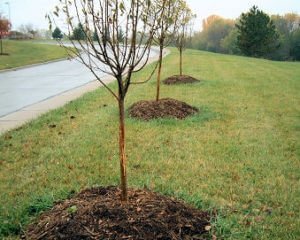
Understanding what damages young trees in winter helps you pick the right protective measures. Some main risks are:
Sunscald / Frost Cracks
On sunny winter days, bark warms, expands, then at night the sudden cold causes contraction and cracking of the bark. This damage—often on the south or southwest side—is called sunscald or frost cracking. Thin-barked species are most susceptible.
Freezing & Thawing Cycles / Soil Heaving
Repeated freezing and thawing cycles can heave soil, pushing roots upward or exposing them to cold air. The repeated cycles also stress roots and can injure them. Mulch helps moderate those fluctuations.
Desiccation & Winter Drought
Even when leafless, trees lose water from stems, buds, or needles (esp. evergreens). Cold winds and dry air exacerbate the water loss, and if roots can’t supply moisture (because of frozen soil), tissues can dry out or die.
Ice, Snow, and Branch Breakage
Heavy snow or ice accumulation can bend or break young branches. Rapid removal of ice can also damage bark or twist limbs.
Animal Damage
During winter, rodents (mice, voles, rabbits) and even deer may nibble bark, chew roots, rub trunks, or break small branches in search of food. Young trees are especially vulnerable.
Salt and Chemical Injury
In cold regions using de-icing salts, runoff or salt spray can injure roots or foliage (for evergreens). Young trees near road edges are particularly exposed.
Late Pruning & Vulnerable Cuts
Fresh pruning late in the season can encourage new growth that doesn’t harden off before winter, leading to frost damage or dieback.
2. Principles of Winter Protection
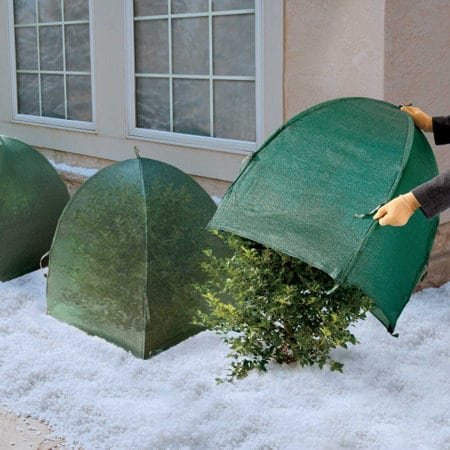
To protect young trees, these guiding principles help you design a robust defense:
- Insulate the root zone and soil from extreme temperature swings.
- Buffer the trunk and branches from sun, wind, and mechanical damage.
- Maintain moisture in soil (within reason) so the tree is not water-stressed before winter.
- Prevent damage by animals using physical barriers or deterrents.
- Provide structural support where needed (stakes, ties).
- Remove coverings in spring to avoid trapping moisture, pests, or girdling.
Let’s transform those principles into actionable steps.
3. Step‑by‑Step: How to Protect a Young Tree in Winter
Here’s a detailed set of steps you can follow.
Step 1: Deep Watering Before Freezes
Before the ground freezes solid, give your young tree a thorough watering so its root zone is moist. Moist soil retains heat better than dry soil, and helps reduce injury to roots.
Water early in the day so the tree can absorb moisture before nightfall. Once the soil is frozen, additional watering won’t help.
Step 2: Mulching
Apply a layer of organic mulch (wood chips, shredded bark, leaf mold) around the base of the tree, about 2–4 inches thick (5–10 cm). Mulch acts as insulation to moderate soil temperature and reduce heaving.
Make sure to keep the mulch a few inches away from the trunk (do not pile it against bark) to avoid rot and rodents hiding under mulch.
The mulch radius should at least cover the root zone, ideally extending to the drip line if space allows.
Step 3: Wrapping / Trunk Protection
To prevent sunscald and frost cracks, wrap the lower trunk of trees—especially those with thin bark—with tree wrap, light-colored paper wrap, burlap or commercial trunk guards.
- Wrap from the base up to the first branch or up to a safe height.
- Wrap loosely (not too tight) to allow for growth.
- Use white or light material (not dark) to reflect heat; avoid dark wraps that absorb heat.
- Remove the wrap in spring after the last frost to avoid pest/bark damage.
Some gardeners also paint the lower trunks (south side) with a diluted white latex paint to reflect light and reduce bark heating.
Step 4: Fencing / Animal Barriers
Place a physical barrier around the tree to block rodents, rabbits, voles, or deer. Options:
- Wire mesh / hardware cloth cylinders around the trunk (about 24–36 inches high) and bury a few inches into soil to deter burrowing.
- Burlap wrap or shrub jackets can also help deter browsing while still allowing air to circulate.
- Fencing in a larger area if deer pressure is high.
Periodically check these barriers to ensure they’re not girdling the trunk or trapping moisture. Remove or adjust as needed.
Step 5: Pruning & Structural Support
Resist the urge to make heavy pruning in late fall—save major structural pruning for late winter/dormant season. Only remove dead or broken limbs before heavy freeze.
If your young tree is tall and exposed to wind, provide staking or support so it isn’t torn by wind or ice. Use soft ties and ensure movement is allowed (trees need some flex). Remove stakes after 1–2 growing seasons when roots are strong.
Step 6: Remove Snow & Ice Carefully
After heavy snow, gently brush off excess snow from branches to reduce weight stress. Don’t attempt to break or chip away ice—this risks damaging bark or branches.
Be gentle: use a soft broom or brush and shake lightly, not jerkily.
Step 7: Monitor & Adjust Through Winter
- Periodically inspect trunk wraps, fencing, mulch, and stakes.
- If wrapping or guards begin to constrict growth, loosen or remove them.
- After freeze-thaw cycles, check for signs of bark splitting or frost crack.
- In early spring, remove all protective wrap or covers before new growth begins.
4. Seasonal Timing & Considerations
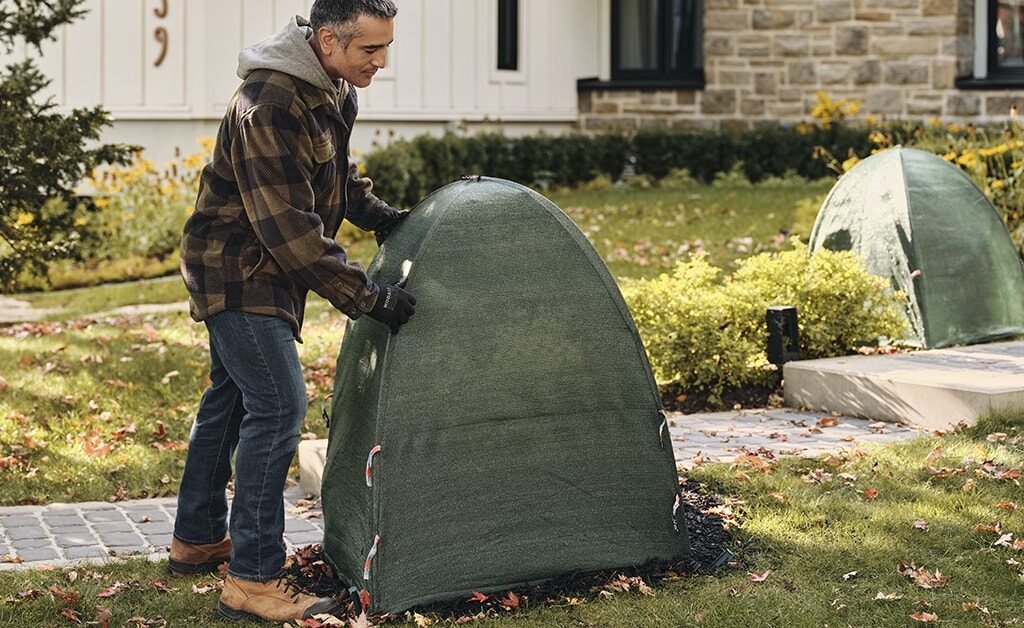
Here’s a rough timeline and how protection changes over the season:
| Time of Year | What to Do | Why It Matters |
|---|---|---|
| Late Fall, before first freeze | Deep watering, mulch, wrap trunks, erect guards, stake if needed | Prepares root zone, prevent early damage, get protection in place before worst cold hits |
| Winter (mid‑season) | Monitor, snow removal, adjust as needed | Shield from ongoing stressors like snow, wind, animals |
| Late Winter / Early Spring (after last frost) | Remove wraps and guards, adjust mulch, prune, inspect injury | Avoid trapping pests, allow new growth unhindered, assess damage |
In some climates, full winter protection may not be necessary; in harsher climates, protective measures must be more stringent.
5. Mistakes to Avoid & Common Pitfalls
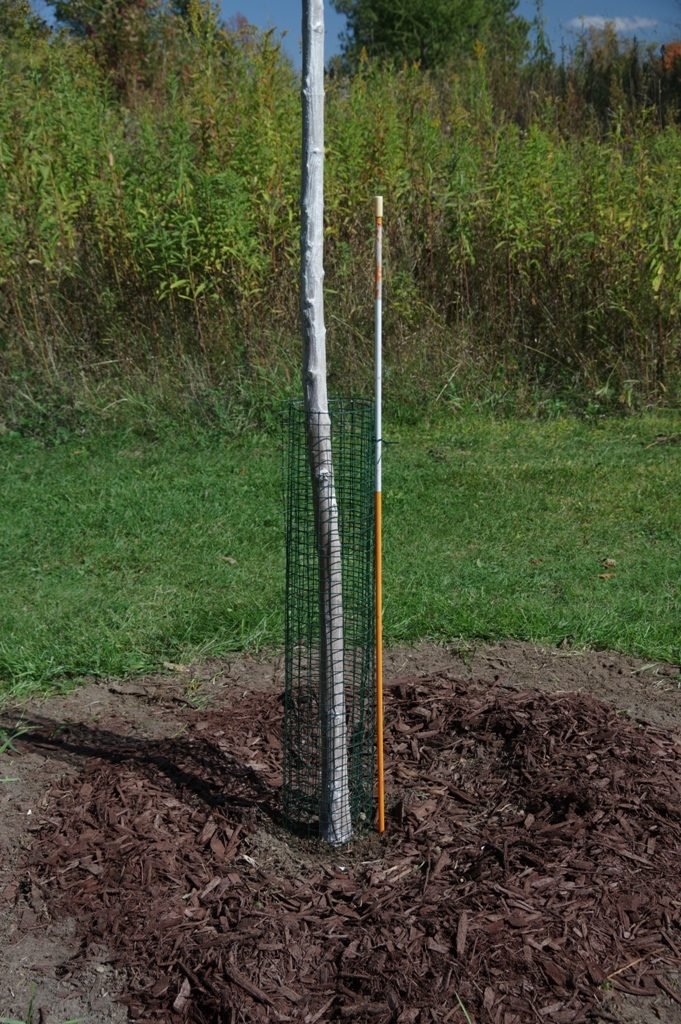
Protecting trees in winter is helpful, but avoid these missteps:
- Wrapping too tightly or leaving wraps year-round — this can girdle the trunk, trap moisture, or harbor pests. Always remove wraps in spring.
- Over-mulching against the trunk (“volcano mulching”) — piling mulch up onto the trunk invites rot and rodent damage. Keep mulch a few centimeters away from bark.
- Pruning too much in fall — encourages new growth vulnerable to freeze damage.
- Neglecting watering before freeze — dry soil offers little protection.
- Using dark wraps or black plastic — these absorb heat during day and amplify temperature swings, increasing risk of bark damage.
- Ignoring animal protection — many damage incidents come from rodents, rabbits, or deer in winter.
- Delayed removal of wraps — leaving them too long increases risk of damage once growth resumes.
6. Long-Term Care & Recovery
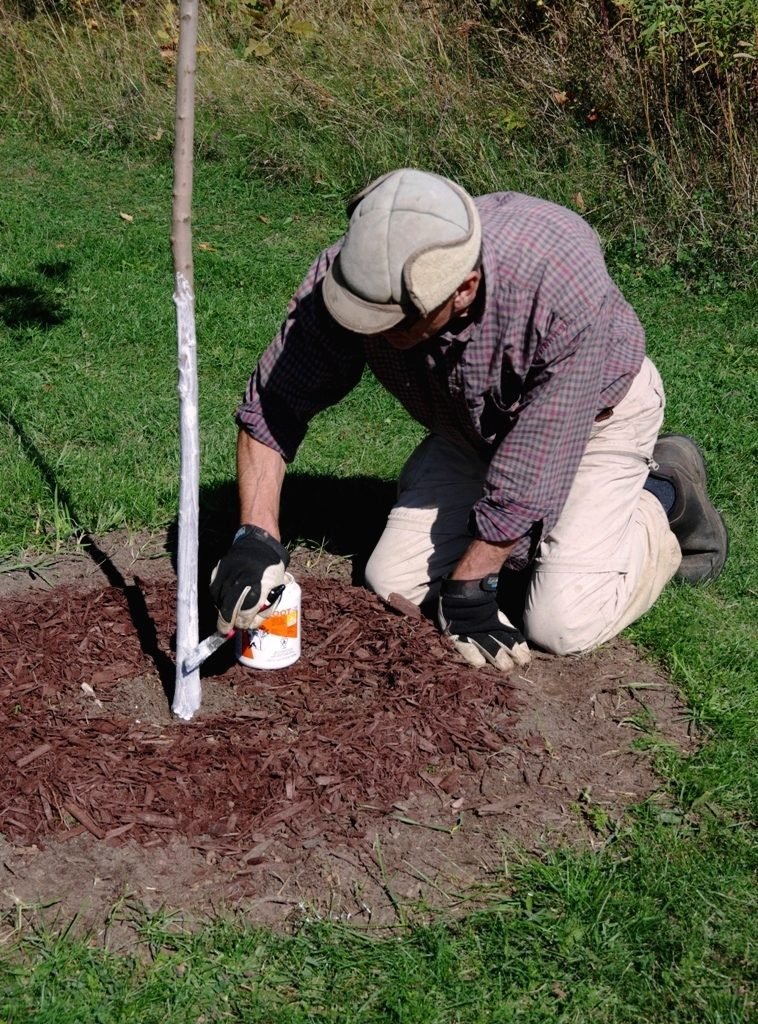
Even with protection, young trees may still show some winter stress. Here’s how to help them recover and strengthen over time:
- In spring, inspect for bark splits, frost cracks, or sunscald injuries. Clean dead bark edges, smooth torn bark, and allow trees to compartmentalize naturally. Avoid sealing with paints or dressings in most cases—trees often heal better without dressings.
- Resume regular care: watering, fertilizing, soil management, and pruning of damaged limbs.
- Monitor for pests or disease, which can take advantage of weakened tissue.
- Gradually reduce protective measures as tree matures: wraps, guard, staking can often be removed after 2–3 seasons, depending on species and vigor.
- Continue mulching, but keep it well managed (renew, reposition, avoid touching trunk).
- Train good structure with pruning in dormant season, favoring strong scaffold branches, correct branching angles, and balanced form.
Example Scenario: Protecting a Young Fruit Tree in a Cold Region
Let’s walk through a hypothetical example:
- In late autumn, after leaf drop, give the tree a deep soak so soil around roots is moist.
- Spread a 3‑inch layer of wood-chip mulch outward from the trunk (but don’t heap near trunk).
- Wrap the lower 1 m of trunk with white tree wrap or light-colored guard.
- Surround the trunk with a 2 ft tall hardware cloth cylinder (buried 4–5 inches).
- Stake the tree with soft ties, leaving some room for movement.
- After heavy snowfall, gently brush snow off branches.
- In late winter, after threat of frost has passed, carefully remove wrapping/guards. Inspect bark for cracks and prune any broken limbs.
- In early spring, resume fertilizing, watering, and structural pruning.
With care, the tree should survive its first winter strong and grow well through spring.
Adaptation for Warmer / Mild Climates (e.g. Nagpur / Maharashtra)
If you are in a climate with mild winters or less freezing (Nagpur region), some of these protections may be less critical—but young trees may still face stress from:
- Dry-season cold (chill nights)
- Strong winds and low humidity
- Sunscald on bright winter or transitional days
- Rodents or pests seeking food
In such a climate:
- Still apply mulch to help root insulation and conserve moisture.
- Wrap trunks if species are sensitive or if bark is thin.
- Monitor watering in dry cold spells (if soil is dry).
- Animal guards may still be useful.
- Snow and ice are unlikely, so that risk is lower.
Focus on convergence: root health + bark protection + pest defense.
Final Thoughts
Young trees hold enormous potential—but winter is one of their most vulnerable phases. By applying well-planned protection—watering, mulching, trunk wrapping, animal guards, support, and careful monitoring—you can significantly increase their chances of survival, reduce damage, and help them emerge vigorous in spring.
Remember:
- Protection is about moderation and appropriateness—don’t overdo or suffocate.
- Timing matters: install protection before harsh cold, and remove coverings early when safe.
- Transition the tree over seasons—don’t leave protections permanently.
- Watch the tree’s response, inspect often, and be ready to adapt.





